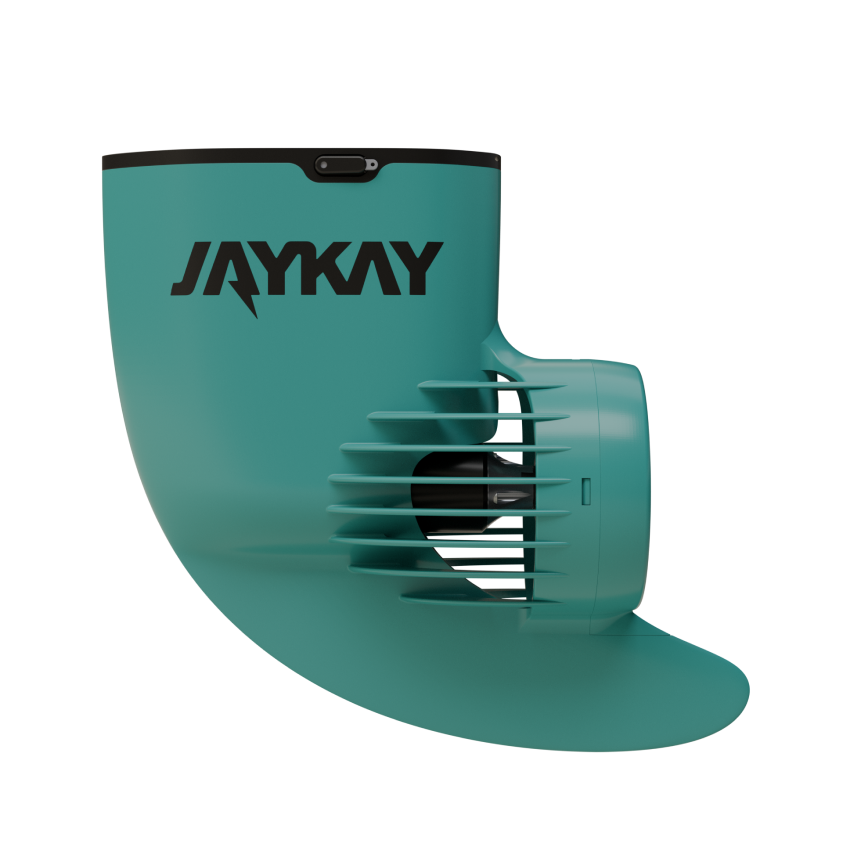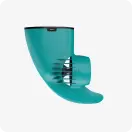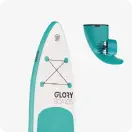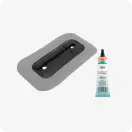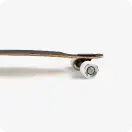Which type and shape of paddle is right for me?

Stand-up paddling (SUP) has become a popular water sports activity in recent years. A crucial component for an optimal SUP experience is the paddle. In this blog post, we'll explore the different types and shapes of paddles to help you find the perfect tool for your next adventure on the water.
Paddle material
Choosing between a plastic, carbon or aluminum paddle depends on several factors, including personal preference, budget and intended use. Here are some considerations for each material option:
- Advantages:
- Affordability: Plastic paddles are often the cheapest option, which makes them attractive for beginners.
- Robustness: Plastic paddles are resistant to bumps and scratches, making them ideal for beginners and rough conditions.
- Environmentally friendly: Some plastic paddles are made from recyclable material, which reduces their environmental impact.
- Disadvantages:
- Heavier: Compared to carbon and aluminum paddles, plastic paddles are often heavier, which can potentially lead to faster fatigue.
- Less performance: plastic paddles may not offer the same performance and efficiency as lighter materials
Carbon paddle:
- Advantages:
- Lightweight: Carbon paddles are lightweight and offer improved maneuverability and efficiency when paddling.
- Stiffness: The stiff structure enables more powerful paddle strokes and more efficient power transmission.
- Performance: Carbon paddles are often the choice of advanced paddlers due to their high performance.
- Disadvantages:
- Cost: Carbon paddles are generally more expensive than paddles made from other materials.
- Sensitivity: Carbon can be more sensitive to strong impacts or improper use.
Aluminum paddle:
- Advantages:
- Durability: Aluminum paddles are robust and resistant to impacts.
- Affordability: Aluminum paddles often offer a good balance between cost and performance.
- Disadvantages:
- Heavier than carbon: Aluminum paddles are heavier than carbon paddles, which can lead to potential fatigue on longer paddling trips.
- Less stiff: Compared to carbon paddles, aluminum paddles can be less stiff.
The choice between plastic, carbon or aluminum depends on your personal preference, your budget and your paddling style. If you are looking for affordability and sturdiness, a plastic paddle might be the right choice. If lightweight and higher performance are a priority and the budget allows es a carbon paddle could be the best option. Aluminum paddles offer a good balance between durability and affordability. Ultimately, es is important to try out different paddles and choose the one that best suits your needs.
Leaf shapes
The shape of the paddle blade plays a crucial role in terms of performance, efficiency and comfort when stand-up paddling (SUP). Here are some common paddle blade shapes and their characteristic features:
Rectangular leaf:
A rectangular blade has clear corners and an even shape. Es offers powerful and stable water control. Paddles with rectangular blades are particularly suitable for beginners as they enable a stable paddle stroke.
Oval leaf:
Oval blades are wider at the base and taper slightly towards the top. This shape improves maneuverability and allows a faster stroke cycle. Oval blades are often found on touring or racing paddles.
Drop-shaped leaf:
The teardrop-shaped blade is narrower at the tip and widens towards the bottom. This shape optimizes the efficiency of forward paddling and is well suited for longer distances or races. Es enables a fluid and fast stroke.
Heart-shaped leaf:
The heart-shaped blade has a wide base, similar to a rectangular blade, but with a rounded tip. This shape combines stability with slightly improved forward paddling. Heart-shaped blades are a good choice for general SUP activities.
Round blade:
Round blades have no sharp corners and offer even power distribution. They are well suited for relaxed paddling and are particularly suitable for beginners or for use in calm waters.
Asymmetrical leaf:
An asymmetrical blade has an inclined shape, with the top edge being larger than the bottom. This improves efficiency and reduces resistance when pulling the paddle out of the water. Es also allows the board to turn faster and more powerfully.
Double concave blade:
Double concave blades have a concave shape on both sides, which optimizes the water flow and enables a stable paddle movement. This blade shape is particularly suitable for paddlers who value control and precision.
When choosing a paddle blade shape, es it is important to consider your personal paddling style, the type of water you want to paddle in, as well as your experience and preferences. Some paddle blade shapes are better suited to certain activities, while others are more versatile and suitable for different conditions. Try out different blade shapes to find out which one best suits your individual SUP experience.
Shaft design
The paddle shaft is an essential part of the stand-up paddle (SUP) paddle, and the design of the shaft has a significant impact on comfort, efficiency and performance when paddling. Here are some common paddle shaft designs and their characteristic features:
Straight shaft:
A straight shaft is simple and straight, with no curvature or bend. This design is classic and offers consistent hand positioning. Es is well suited to paddlers who prefer a conventional paddling style.
Ergonomically curved shaft:
An ergonomically curved shaft has a slight bend or curve. This design adapts more naturally to the hand and arm position and can help reduce strain and fatigue. Es is particularly comfortable for longer paddling trips.
Divisible shaft:
A divisible shaft allows es the paddle to be split into two parts, making it easier to transport and store. This is particularly practical for paddlers who travel a lot or have limited storage space.
Adjustable shaft:
An adjustable shaft allows you to adjust the length of the paddle. This is useful if the paddle is used by different people or if you want to vary the length depending on the paddling conditions.
Carbon shaft:
A carbon shaft is light and stiff, resulting in efficient power transmission. This shaft option is particularly popular with experienced paddlers who value performance.
Aluminum shaft:
An aluminum shaft is more robust and more resistant to impacts. Aluminum shafts are often found in more affordable paddle models and are a good choice for beginners.
Oval shaft:
An oval shaft has an oval shape, resulting in a natural hand positioning. This design can help minimize twisting of the paddle in the hand and improve grip comfort.
T-Grip:
The T-Grip is the upper grip shape of the paddle shaft. It has the shape of a "T" and offers comfortable hand positioning. This type of grip is well suited to paddlers who value precision and control.
Conclusion: Choosing the right paddle is crucial for an optimal SUP experience. Es depends on individual preference, experience level and budget. Regardless of whether you prefer an adjustable, fixed, carbon or aluminum paddle, as well as the shape of the blade and the design of the shaft, es it is important to explore the different options and choose the paddle that best suits you and your stand-up paddle board.
However, after your first SUP season at the latest, you will realize that an inexpensive aluminium paddle was a good choice for the beginning, but if you want to practice the sport regularly, there is no way around a fibreglass, carbon composite or carbon paddle. An aluminum paddle is too heavy in the long run and puts a strain on your shoulders on longer trips. An aluminum paddle is sufficient for occasional paddling, but if you want to practice this water sport with sporting ambitions, you should look for a high-quality SUP paddle. But high-quality does not automatically mean expensive! Numerous manufacturers offer carbon paddles with an excellent price-performance ratio.
For us, the 2-component paddles, where the blade is often made of plastic and the tube is made of carbon, are ideal. On the one hand, these paddles are cheaper than pure carbon paddles, on the other hand they are also more robust against impacts on stones or similar (which can often happen with beginners). So if you want to buy a SUP paddle as a beginner - we recommend this variant.
A small note: SUP paddles should always be able to float so that they do not sink if es lands in the water unintentionally. This can sometimes happen, especially with the cheaper versions.
